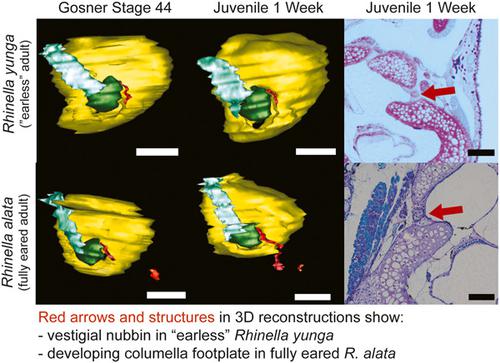当前位置:
X-MOL 学术
›
Evol. Dev.
›
论文详情
Our official English website, www.x-mol.net, welcomes your
feedback! (Note: you will need to create a separate account there.)
Whispers from vestigial nubbins: Arrested development provokes trait loss in toads
Evolution and Development ( IF 2.6 ) Pub Date : 2020-10-27 , DOI: 10.1111/ede.12356 Jennifer L Stynoski 1, 2 , Molly C Womack 1, 3 , Florencia A Trama 4, 5 , Luis A Coloma 6 , Kim L Hoke 1
Evolution and Development ( IF 2.6 ) Pub Date : 2020-10-27 , DOI: 10.1111/ede.12356 Jennifer L Stynoski 1, 2 , Molly C Womack 1, 3 , Florencia A Trama 4, 5 , Luis A Coloma 6 , Kim L Hoke 1
Affiliation

|
Despite the use of acoustic communication, many species of toads (family Bufonidae) have lost parts of the tympanic middle ear, representing at least 12 independent evolutionary occurrences of trait loss. The comparative development of the tympanic middle ear in toads is poorly understood. Here, we compared middle ear development among two pairs of closely related toad species in the genera Atelopus and Rhinella that have (eared) or lack (earless) middle ear structures. We bred toads in Peru and Ecuador, preserved developmental series from tadpoles to juveniles, and examined ontogenetic timing and volume of the otic capsule, oval window, operculum, opercularis muscle, columella (stapes), and extracolumella in three‐dimensional histological reconstructions. All species had similar ontogenesis of the otic capsule, oval window, operculum, and opercularis muscle. Moreover, cell clusters of primordial columella in the oval window appeared just before metamorphosis in both eared and earless lineages. However, in earless lineages, the cell clusters either remained as small nubbins or cell buds in the location of the columella footplate within the oval window or disappeared by juvenile and adult stages. Thus, columella growth began around metamorphosis in all species but was truncated and/or degenerated after metamorphosis in earless species, leaving earless adults with morphology typical of metamorphic anurans. Shifts in the timing or expression of biochemical pathways that regulate the extension or differentiation of the columella after metamorphosis may be the developmental mechanism underlying convergent trait loss among toad lineages.
中文翻译:

来自退化小块的耳语:发育受阻会导致蟾蜍性状丧失
尽管使用了声音交流,但许多蟾蜍(蟾蜍科)已经失去了部分鼓膜中耳,这代表了至少 12 次独立的性状丧失进化事件。蟾蜍鼓室中耳的比较发育知之甚少。在这里,我们比较了Atelopus和Rhinella属中两对密切相关的蟾蜍物种的中耳发育有(有耳)或缺乏(无耳)中耳结构。我们在秘鲁和厄瓜多尔培育了蟾蜍,保存了从蝌蚪到幼体的发育系列,并在三维组织学重建中检查了耳囊、卵圆窗、耳盖、耳盖肌、小柱(镫骨)和小柱外的个体发育时间和体积。所有物种的耳囊、卵圆窗、鳃盖和鳃盖肌的个体发生相似。此外,椭圆形窗口中的原始小柱细胞簇出现在有耳和无耳谱系的变态之前。然而,在无耳谱系中,细胞簇要么作为小块或细胞芽保留在椭圆形窗口内的小柱足板位置,要么在幼年和成年阶段消失。因此,在所有物种的变态前后,小柱开始生长,但在无耳物种的变态后被截断和/或退化,使无耳成虫具有典型的变态无尾目形态。调节变态后小柱延伸或分化的生化途径的时间或表达的变化可能是蟾蜍谱系中收敛性状丧失的发育机制。
更新日期:2021-01-05
中文翻译:

来自退化小块的耳语:发育受阻会导致蟾蜍性状丧失
尽管使用了声音交流,但许多蟾蜍(蟾蜍科)已经失去了部分鼓膜中耳,这代表了至少 12 次独立的性状丧失进化事件。蟾蜍鼓室中耳的比较发育知之甚少。在这里,我们比较了Atelopus和Rhinella属中两对密切相关的蟾蜍物种的中耳发育有(有耳)或缺乏(无耳)中耳结构。我们在秘鲁和厄瓜多尔培育了蟾蜍,保存了从蝌蚪到幼体的发育系列,并在三维组织学重建中检查了耳囊、卵圆窗、耳盖、耳盖肌、小柱(镫骨)和小柱外的个体发育时间和体积。所有物种的耳囊、卵圆窗、鳃盖和鳃盖肌的个体发生相似。此外,椭圆形窗口中的原始小柱细胞簇出现在有耳和无耳谱系的变态之前。然而,在无耳谱系中,细胞簇要么作为小块或细胞芽保留在椭圆形窗口内的小柱足板位置,要么在幼年和成年阶段消失。因此,在所有物种的变态前后,小柱开始生长,但在无耳物种的变态后被截断和/或退化,使无耳成虫具有典型的变态无尾目形态。调节变态后小柱延伸或分化的生化途径的时间或表达的变化可能是蟾蜍谱系中收敛性状丧失的发育机制。











































 京公网安备 11010802027423号
京公网安备 11010802027423号